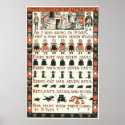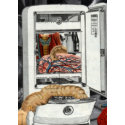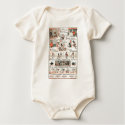A recipe from Successful Baking For Flavor & Texture by Martha Lee Anderson, copyright 1937, Church & Dwight Company (makers of Arm & Hammer and Cow Brand baking sodas).
Wednesday, October 30, 2013
Raisin Rock Cookies
Posted by Deanna Dahlsad
0
comments
Labels:
Cooking,
Recipes
![]()
Pretty Stenciled Pie Crusts
Posted by Deanna DahlsadFrom the September 1978 issue of Decorating & Craft Ideas Magazine, which has the stencil patterns, pie crust recipes, as well as recipes for fruit pies and vegetable and beef pies, and how-to information. Confident cooks can just be inspired to paint their own pies with with egg yolk and food coloring.
0
comments
Labels:
Cooking,
Crafty,
Entertainment,
Food,
Traditions
![]()
Tuesday, October 29, 2013
How To Remove Stains From Marble (And Info On Soft & Hard Soaps)
Posted by Deanna DahlsadTips from Godey’s Lady’s Book, January 1855:
Method 1 – Mix equal quantities of fresh spirit of vitriol and lemon-juice in a bottle; shake well; wet the spots, and in a few minutes rub with a soft rag until they disappear. Another mode is to sponge the spots with a weak solution of muriatic acid or aquafortis.
Method 2 – If the marble be stained with oils, mix soft soap, fuller’s earth, and hot water into a paste; cover the spots with the paste, and let it dry on. The next day scour it off with soft or yellow soap.
Method 3 – Boil half, a pound of soft soap in a quart of water, very slowly, until the water is reduced to a pint. Apply this in the same manner as the preceding.
You'll see that I added some links to help you; but here are a few other notes.
Regarding "soft soap," as it was in the 1800s: Soft soap is traditionally discussed as that made simply by omitting the salt from your soap recipe process, keeping the soap in a jelly-like state. Soap with salt creates the "hard soap" most of us are familiar with. However, many soap makers will also tell you that the firmness of a soap will also depend upon the type of grease or fat used to make it. Hard soaps come from "hard fats." Hard fats are those which melt at a higher temperature: beef, goat, sheep and lamb. "Soft fats", those which melt at lower temperatures, such as chicken or pork, will soften your soap -- even if only used in combination with other, harder, fats. "Yellow soap" is a hard soap made from tallow (fat from cattle and sheep) and resin (salts).
Why two kinds of soap? Different uses -- which are largely based on thrift. Since you can control (and so spare) the amount of soft soap taken from the barrel or jar stored in, soft soap is ideal for spot cleaning like stain removal. Soft soaps were also often used for washing dishes and floors because you could rather easily guesstimate the amount of soap needed and only put that much in the bucket -- and, because soft soaps dissolve easier than hard soaps, you don't wait long for the soap to be ready to use. Hard or bar soaps are best used for bathing, where the hard soap takes longer to break down and so lasts through however long it is put to use in the bath or shower. Hard soaps were also used for laundry for similar reasons; one bar to last for a longer amount of time, still leaving you with soap when the chore is finished.
There's no reason why you couldn't try soap jelly or other thrifty soap tips. However, if you want a more historically authentic experience, check out Grandpappy's Homemade Soap Recipes. Also, if you've been thinking of using your leftover bacon grease to make soap, you might want to read this first.
0
comments
Labels:
Guides,
Household Tips,
Vintage Living
![]()
Tuesday, October 22, 2013
Simple Table Setting Ideas
Posted by Deanna DahlsadThese photos were found in an article entitled Sit Down to Handmade Table Settings inside the October 1980 issue of Decorating & Craft Ideas magazine. Since the holidays are nearly upon us, and entertaining is ever-certain at holiday times, I thought these were pretty nifty.
The first idea is to use a large pottery bowl as an ice bucket. On large tables, you can have several of these with individual bottles for guests. (Also a great game day idea!)
The second idea is to use wooden chopping blocks or bread boards as placemats.This would be ingenious any time of the year -- especially when reheating leftovers in the microwave. I remember my grandma using wooden boards to carry casseroles and hotdishes out to the table; using individual ones for carrying and serving food on plates from the microwave is the same idea. And wooden boards are not only very stable to carry, they are easy to clean, economical to reuse, and most often considered the healthier choice. (Wood cutting boards are also easier on your knives.)
0
comments
Labels:
Home Decor,
Household Tips,
Safety,
Vintage Living
![]()
Wednesday, October 9, 2013
Seeing The Truth About Good Clean Vintage Living & Eyeglasses
Posted by Deanna DahlsadIf cleanliness is next to godliness, then good eyeglasses must be like prayers -- because it is much easier to arrive at "clean" when you can see well!
I know that many of us who are into vintage living like to use authentic vintage items and wear authentic vintage fashions as often as we can; it's thrifty, good for the environment, and it's fun. But when it comes to cleaning-up the house, garage, or yard I don't recommend wearing authentic vintage eyewear, especially not prescription glasses. Not even if you are far-sighted or, as I must do now, wear bifocals. The risks are just too great.
Vintage eyewear is pricey now, especially the most iconic styles from the 1940s through the 1960s. Eyeglasses from those decades are increasing in popularity and therefore price. Today, simple and traditional cat-eye glasses and funky round mid-century mod glasses easily go for between $50 and $100 -- and that's not including the designer names like Dior or Schiaparelli, where you can expect prices to at least double. And it is not thrifty to put such pretty pricey pieces at risk. (Not to mention the heartbreak if you destroy a one-of-a-kind vintage piece!)
While it is true that if the vintage eyeglass frames are in good condition, they can be worn everyday (and often can even withstand the process of having modern prescription lenses put in), however vintage glasses are not up to facing the challenges of cleaning house. Aside from the hazards of bumps and falls involved in such rigorous work, vintage glasses are not prepared to meet modern day cleaning chemicals. In fact, many of the old frames are made of plastics, rhinestones, and other materials which are not even well-suited to withstand the sweat of your brow; like vintage jewelry, they should be kept safe and dry.
The good news is that many eyeglass companies make cat-eye and other vintage-styles frames. (Like the Lupo 5599 Marbled Stripes eyeglasses shown in this post.)
Thanks to our friends at GlassesUSA.com, you can take 10% off any order of prescription glasses simply by using this special shopping code when you order glasses: Blog10.
This 10% savings is on top of their 110% lowest price guarantee and 100% satisfaction guarantee on their high quality frames and lenses. GlassesUSA.com also has a refer-a-friend program. All of this just makes sparing your vintage glasses the wise and thrifty thing to do.
0
comments
Labels:
Bargains,
Household Tips,
Safety,
Shopping Tips,
Vintage Living
![]()

























